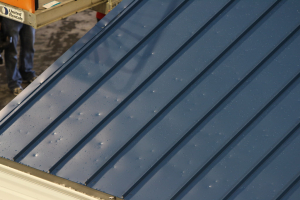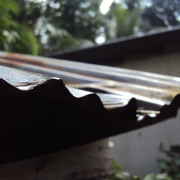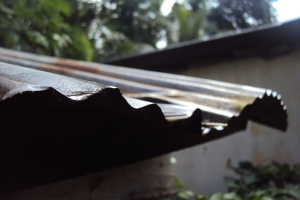Standing Seam Metal Roof Hail Damage
Some people believe that any type of metal roofing will eventually be dented or damaged by hail storms. However, this is actually a myth.
In truth, most hailstorm don’t create hailstones that are large enough to actually cause any hail damage metal roof. Unfortunately, there are some areas where hailstorms are strong enough and create hailstones that are damaging to your property. In these cases, home insurance is essential.
This is one of the reasons why it is just essential to ask this critical question when it comes to hail storms – How can hail damage metal roof?

The impact of hail on a property is a commonly discussed topic. Aside from your roof, hail frequently causes damage to other parts of your home, as well as other outdoor items that are left unguarded. With a roof especially, damage can be extreme depending on the strength of a hail event. The truth is that hail can affect a metal roof in more ways than one.
By nature, most of the metal material types, such as steel, aluminum, copper, etc., used in metal roofing systems are malleable and therefore can change shape under stress.
There are 2 main ways in which a metal roof is affected by hail. This is either through denting or puncturing damage. Denting occurs when an area of the metal roof sinks in due to the weight and force of an impacted hail stone. The severity of the dent will depend on the size of the hail stone and how strong or fast it was falling. Denting, while it may look bad, is mainly an aesthetic issue. It will definitely make your roof look bad but does not have any major effects to the structural integrity of the structure. Denting does not require structural fixes and might be the best-case scenario when compared to a punctured roof system.
The other form of damage which a hail event can cause on your roof are roof punctures. This refers to when a hail stone actually damages the metal roof and forms a hole.
This is not merely a cosmetic damage to your property and can actually cause further problems, such as roof leakage. Compared to denting, however, puncturing is a much less likely occurrence since most hail storms produce smaller hailstones.
Factors That Can Affect the Level of Hail Damage on metal roof
As mentioned earlier, the level of damage on your property is highly dependent on the strength and severity of the hail storm. The stronger the event, the higher the likelihood for major damages from punctures. Essentially, the level of physical hail damage on metal roof system varies and is dependent on these main factors.
Hail Size
One of the main factors to consider is the size of the hail that impacts your roof. Bigger hail stones tend to cause larger dents while smaller ones may not even scratch your roof at all.
Metal Thickness
The thickness of your metal roof panels also matters. Thicker metal panels are much more durable and can withstand stronger hail events than thinner and more malleable material.
Slope of the Roof
Flat or low-sloped roofs tend to take more damage since hail is likely to impact the metal roof directly. On the other hand, roofs with a higher slope are less likely to be directly hit. However, this will also depend on the angle by which hail falls from the sky.
Type of Roof Deck
The supporting structure underneath your metal roof also affects the level of damage it retains. Roof decks which are solid provide strong support to metal panels and prevent them from flexing during a hail storm. Because of this, metal roofs with a solid deck support might not receive as much damage. Unfortunately, if the metal roof is not installed on top of a roof deck and is on top of either open framing or a batten system, the open space underneath the panels can cause it to form dents more easily.
Embossed Metal
Metal roofs that are embossed don’t necessarily protect the roof from damage during a hail storm. Instead, this type of finish can better conceal any dents or creases from such an event. The only downside, however, is that an embossed metal finish on your roof costs more.
Keeping these in mind, the only thing that you can do after a hail storm is to assess the damage done to your property. Our team at Waddle Exteriors can give you some of our expertise in inspecting, assessing, and evaluating the damage to provide you the best possible solution.





